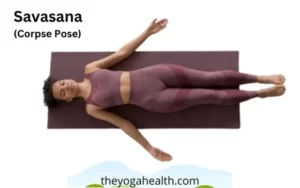Boat Pose Yoga or Paripurna Navasana is a basic pose of Hatha yoga. ‘Paripurna’ in the Sanskrit language means ‘complete’ and ‘Nava’ means a ‘boat’. This asana resembles like a boat with oars, thus the name.
The Boat Pose is a powerful yoga posture that engages your core muscles and enhances your body’s balance. In this article, we will explore the benefits, step-by-step instructions, and variations of the Boat Pose.
So, let’s dive in and discover the wonders of this empowering Yoga Pose.

Table of Contents
Boat Pose (Navasana)
The Boat Pose, also known as Navasana in Sanskrit, is a fundamental yoga asana that primarily targets the abdominal muscles, hip flexors, and spine. This posture resembles the shape of a boat from where it has got its name.
By practicing Boat Pose regularly, you can strengthen your core, improve digestion, and boost your overall body awareness and balance.
Boat Pose Yoga Basic Details
| Common Name | Navasana |
| Sanskrit Name | Paripurna Navasana, Naukasana |
| English Name | Complete Boat Pose |
| Difficulty Level | Intermediate |
| Position | Sitting |
| Ayurveda Dosha | Pitta |
Boat Pose Yoga benefits following Muscles:
- Core (ABS)
- Lower Back
- Pelvic
- Gluteus
- hip flexors
Story from ancient India
There are many references to the boat from the literature of ancient India, whereby Sage Manu, the author of Manu Smriti, carried the sacred Vedas, along with seven sages in a boat during the great flood.
The Boat was tied to the horn of the fish and the boat reached safely a resting space atop Mount Meru.
How to do Boat Pose Yoga
1. Sit on your yoga mat keeping your legs stretched on the floor in front of you. Place your palms on the floor by your hips, your fingers should point towards your feet.
2. Now keep your back erect, and stretch your hands straight. This posture is known as ‘Dandasana’. Where ‘Dand’ means a ‘rod’ and ‘asana’ means a ‘pose’.
3. Breath out, slightly move your upper body back, and simultaneously raise your legs from the floor. Keep your legs stiff and your knees tight, your toes pointing forwards.
4. You have to maintain your balance on your buttocks and no part of your spine should touch the floor. You have to keep your legs higher than your head at about the angle of 60 to 65 degrees from the floor. Do not keep your feet at the level of your head as is done in ‘Ardh Navasana’
5. Now remove your hands from the floor and stretch your arms in front of you, keeping your arms parallel to the floor and near your thighs. Your shoulders and your palms should be on one level and your palms should face each other.
6. You can hold this pose for about 30 seconds with normal breathing. You will only feel the effect of the asana after 20 seconds. You can gradually increase the time to stay in the pose from 30 seconds to about one minute.
7. To come out of the pose, breathe out and lower your hands and legs on the floor. Lie down on your back and relax.
Boat Pose Benefits
Boat Pose, also known as Navasana, is a yoga posture that offers numerous benefits for your body and overall well-being.
In this article, we will explore the incredible advantages of practicing this Pose and how it can positively impact your health.
1. Relief from Gastric Complaints
One of the significant benefits of Boat Pose is its ability to provide relief to individuals suffering from gastric complaints.
If you often experience a bloating sensation or discomfort due to excessive gas in your stomach, this asana can help alleviate those symptoms. By practicing this Pose regularly, you can find relief and promote a healthier digestive system.
2. Strengthening and Toning the Kidneys
Boat Pose not only targets the core muscles but also engages and strengthens the kidneys. As you hold the pose, your kidneys experience a gentle workout, improving their overall function and promoting better kidney health.
Regular practice of this asana can help maintain the optimal functioning of your kidneys, an essential part of your body’s filtration system.
3. Reducing Waistline Fat
If you’re looking to trim your waistline and shed some excess fat, Boat Pose can be a valuable addition to your fitness routine. This pose activates and engages the abdominal muscles.
By consistently practicing this Pose, you can tone and strengthen your core, which contributes to reducing fat around your waistline and achieving a more defined midsection.
4. Building Abdominal and Core Strength
Boat Pose is renowned for its ability to strengthen and tone the abdominal and core muscles. By consistently practicing this asana, you can develop a stronger core, which is vital for overall stability and balance.
Strong abdominal and core muscles not only enhance your physical appearance but also provide a solid foundation for performing various physical activities with ease and efficiency.
5. Beneficial for Individuals with Hernia
Boat Pose is considered beneficial for individuals dealing with a hernia problem. While it’s essential to consult with a healthcare professional before attempting any yoga pose with a pre-existing condition.
Practicing this Pose under proper guidance can help strengthen the abdominal muscles and provide support to individuals with a hernia.
6. Strengthening the Spine
This Pose is an excellent exercise for giving strength to your spine. As you hold the pose, your back muscles engage, providing support and stability to your spine.
Regular practice can help improve posture, relieve back pain, and enhance the overall health and strength of your spinal column.
7. Stimulating Glands and Intestines
This asana stimulates various glands and organs in your body. It activates the thyroid and prostate glands, promoting their optimal functioning.
Additionally, it stimulates the intestines, aiding in better digestion and improving overall digestive health.
8. Improved Digestion
This Pose can significantly improve digestion by massaging and stimulating the digestive organs. As you hold the pose, the compression on the abdominal area helps enhance digestion and metabolism.
Practicing this Pose regularly can alleviate common digestive issues such as indigestion, bloating, and constipation, allowing for a more comfortable and efficient digestive process.
9. Stress Relief
In today’s fast-paced working environment, stress has become a common part of our lives. This Pose offers an opportunity to relieve stress and calm the mind. As you focus on balancing in this pose, your mind becomes more present.
Incorporating this Pose into your routine can help reduce stress levels and promote mental well-being.
Boat Pose yoga Tips
These tips will help beginner practitioners from injuries and help them in perfecting their pose.
- Those yoga practitioners who are new to the world of yoga can start with Ardha Navasana before going full-fledged for Paripurna Navasana
- It will be better to practice this pose at the beginning of the yoga class to prepare your core for the rest of your poses.
- If practitioners find it difficult to raise their legs then they can keep their hands on the floor beside their hips or they can also holdbacks of their thighs with their hands.
- Those practitioners who find it difficult to straighten their raised legs, can bend their knees and put a strap around the soles of their feet.
- To practice this pose with a strap, they can inhale and lean their torso back and then exhale and lift and try to straighten their legs by pushing their feet as firmly as possible against the strap.

Boat Pose Common Mistakes
- The practitioners, in the beginning, think that the pose is about strengthening their leg muscles, and to achieve that target they forgot to straighten their spine and upper body.
- Keeping your legs straight and your spine slumped or round will defeat the purpose of this pose.
- Another mistake the beginners make is that they hold their breath while doing the pose. It is a wrong approach to the pose, breathing is the most important part of this pose to take full benefit out of the pose.
- While doing the pose the breathing should be normal inhalation and exhalation and in no case practitioner has to hold his breath, which they are most likely to do in the beginning.
Boat Pose variations and modifications
- Practitioners can hold the back of their thighs with their hands if that helps them to keep their spine straight.
- Keeping your back straight and away from the floor is more important in this pose than straightening your legs. Don’t rush for straightening your legs as a prime target of the pose.
- In the beginning, you can take the help of the strap on the soles of your feet to help you straighten your legs.
Boat Pose Contraindications
- If you are suffering from low blood pressure then avoid this pose.
- If you are having severe headaches or migraine then also you can avoid this pose
- People suffering from Asthma and heart patients are also advised to refrain from this pose.
- Women during pregnancy should not do this pose
- Women and girls during menstruation can avoid this pose.
Conclusion
The body in a Boat Pose Yoga (Navasana) is entirely balanced on the buttocks or the sit bones and the legs and the arms are balanced in the air using the core muscle strength.
This pose looks very simple from the outside but it requires tremendous abdominal power and balance to perfect this pose.
Incorporating this Pose into your fitness routine can bring about a wide range of benefits, from relieving gastric complaints and strengthening your core to improving digestion and reducing stress.
With regular practice, this pose helps to strengthen the abdominal muscles, core, spine, muscles of the back, hip flexors, and pelvis along with a perfect sense of balance.
FAQs: Boat Pose Yoga
Q1. What are the benefits of navasana?
Ans: This asana is very helpful to those suffering from gastric complaints, gas and bloating sensation in the stomach strengthens and tones the kidneys.
It reduce fat, helps to build abdominal and core strength, in hernia problem, strengthen the spine, stimulates the thyroid and prostate glands and intestines, Improves digestion, relieve stress.
Q2. Why is boat pose so difficult?
Ans: One of the main reasons or difficulty in doing this pose is that it requires tremendous core strength which can only be attained with regular practice of yoga poses that strengthen the core (abs).
Q3. How long to hold the boat pose?
Ans: You can hold this pose for about 30 seconds with normal breathing. You will only feel the effect of the asana after 20 seconds.
You can gradually increase the time to stay in the pose from 30 seconds to about one minute.
Share your experience of doing this Pose and let us know if you have any questions or comments regarding this Pose in the comments section below.





